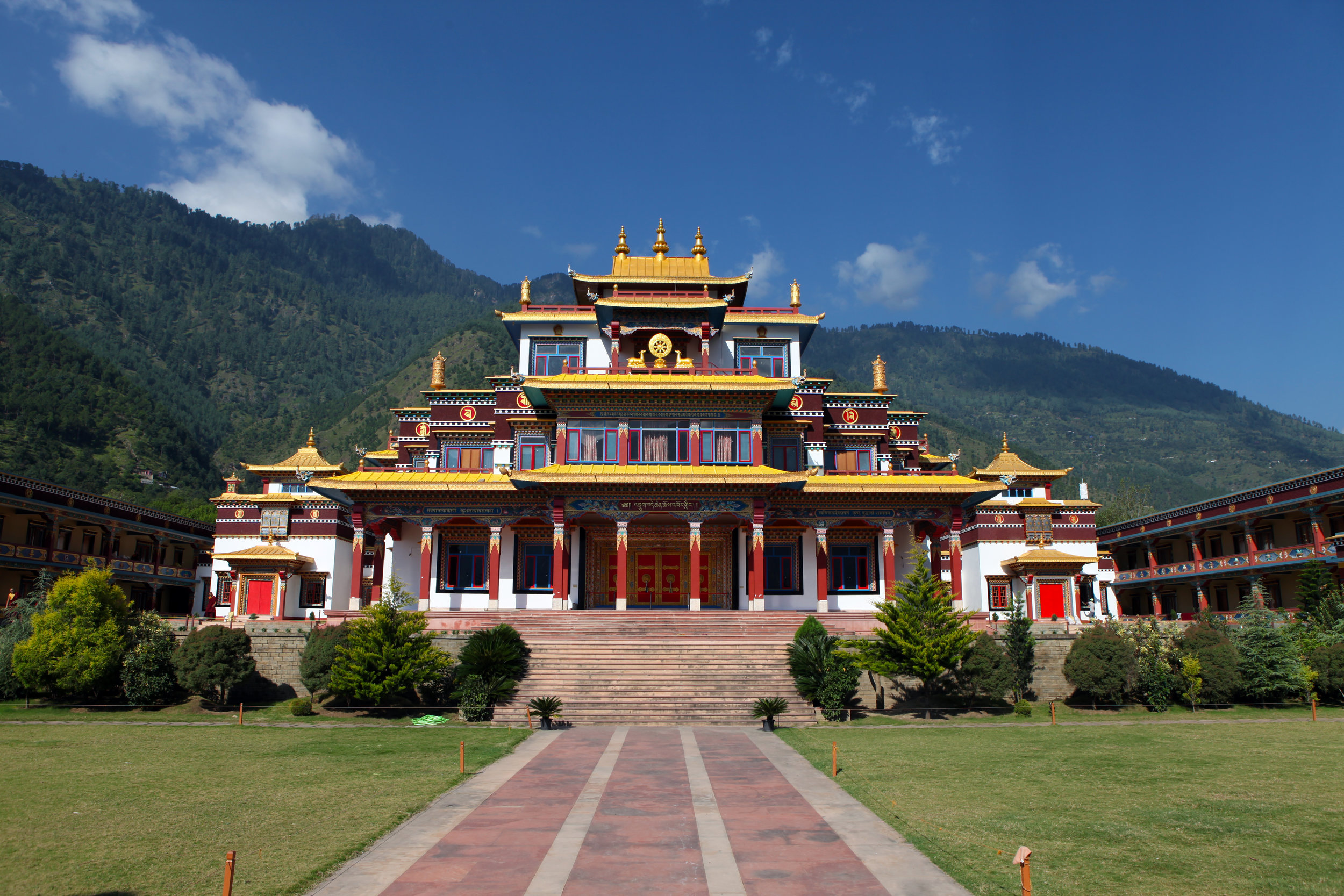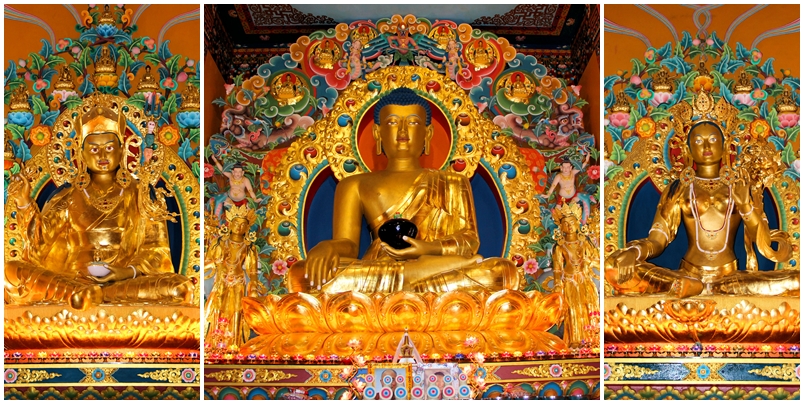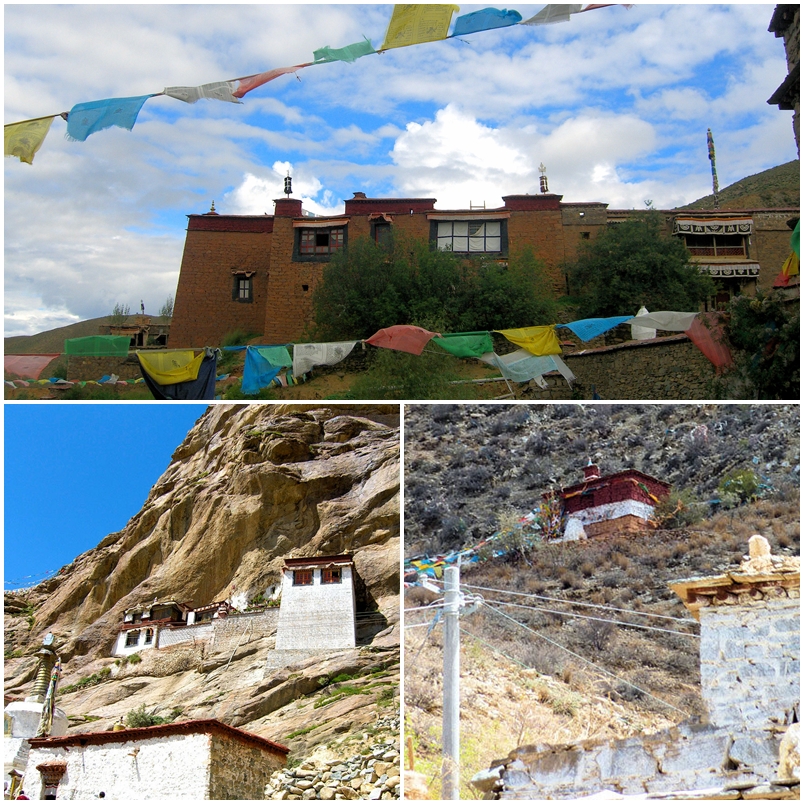Since its inception in the early 16th century, Dechen Choekhor, particularly the Lineage of Drukpa Choegon Rinpoches, has persevered for over 500 years to preserve the purity and intactness of Drukpa Kargyu Lineage through great resoluteness and dedication. Dechen Choekhor completely held to the Lineage of the Drukpa Kargyu like its ancestral origin or the source of the river.
~ The 8th Adeu Rinpoche ~
About Dechen Choekhor
Dechen Choekhor Mahavihara is a faith-based, non-profit organization dedicated to propagating the authentic living tradition and essence of Tibetan Buddhism to benefit all sentient beings.
The newly reestablished Dechen Choekhor Monastery in Kullu, H.P. India, was officially inaugurated in early October 2017.
Dechen Choekhor Mahavihara and its surrounding mountains were covered with snow during winter.
The three main giant Buddha statues of Dechen Choekhor (from left): The 21ft Guru Rinpoche; the 31ft Buddha Sakyamuni; and the 21ft Green Tara.
The missions and visions of Dechen Choekhor Mahavihara are to:
Preserve and promote the Tibetan cultures and traditions, particularly the sublime Vajrayana teachings of Lord Buddha through the unbroken lineage of Drukpa Kargyu.
Promote a peace-loving, harmonious and caring society by applying the Buddhist principles; and encourage naturalistic understanding, positive social engagement, and ongoing mental development.
Foster a consistent and accurate understanding of Tibetan Buddhist teachings and practices.
Brief History of Dechen Choekhor
In ancient Tibet, the sacred Land of Snows, Druk Dechen Choekhor Ling, is the historical mother-monastery of great importance to Drukpa Kargyu Lineage and the seat of both Drukpa Choegon Rinpoche - an emanation of Vajrapani, and Drukpa Yongzin Rinpoche - an emanation of Manjushri for centuries. These two great masters are traditionally known as the "Chokzig Namnyi," meaning "the two who possess the supreme view."
Druk Dechen Choekhor Ling at Gongkar, Tibet.
'De' means bliss, 'Chen' means great; 'Choe' means Dharma, 'Khor' means abode - "The Dharma Abode of Great Bliss" is what it denotes. Dechen Choekhor being the foremost seat of the Drukpa Kargyu Lineage in Tibet, was the cultural focal point for more than 300 monasteries that branched out from it in the 16th century, including the Khampagar of Khamtrul Rinpoche in Eastern Tibet; the Hemis Monastery, Chemey Monastery and Korzog Monastery in Ladakh; the Dorzong Monastery in Tibet, etc. Tsechu Monastery of Trulshik Adeu Rinpoche in Nangchen, Qinghai, is a direct branch monastery of Khampagar.
Top: The side view of Dechen Choekhor Tibet. Bottom: The retreat houses of Dechen Choekhor Tibet designated for the intensive practice of the lineage teachings.
Since its inception in the early 16th century, Dechen Choekhor, particularly the Lineage of Drukpa Choegon Rinpoches, has held the Lineage intact, pure and unbroken through great resoluteness and dedication. Their perseverance and diligence in practices and preservation have successfully upheld the lineage's essence and purity for close to 500 years. Until today, Dechen Choekhor remains the main and primary source for lineage teachings and practices of the Drukpa Kargyu.
The giant Buddha Sakyamuni's thangka is being unfolded at Dechen Choekhor Tibet.
The need TO Re-establishing Dechen Choekhor
In the 16th century, when Dechen Choekhor was initially founded, it was comparable to the great Buddhist universities of India and the great schools of theology and classical learning in medieval Europe. Many students came from far and wide across the Himalayan regions to study at Dechen Choekhor because it was well known for its training of Lineage-Holding Rinpoches, tulkus, and monks. Unfortunately, most of its structures and buildings were destroyed in the 1960s, thus rendering it functionless in offering large-scale teachings. Today, as the survival of the authentic Tibetan culture and religion grows ever more uncertain, the reestablishment of Dechen Choekhor Monastery is of dire importance.
Although there are over hundreds of Dechen Choekhor’s branch-out monasteries in the Himalayan region, there are still many monks and nuns who wish to be trained under the pure tradition of Dechen Choekhor but have no main monastery in which to do so. They have raised numerous requests to both the previous and present Choegon Rinpoche to rebuild his principal monastery so that future generations would be able to receive the Drukpa Kargyu training directly from its mother monastery.
The three root-gurus of the present Choegon Rinpoche (from left): The 8th Khamtrul Rinpoche, The 8th Adeu Rinpoche and Dilgo Khyentse Rinpoche.
The teachers of the present Choegon Rinpoche: H.H. Dilgo Khyentse Rinpoche, the 8th Kyabje Khamtrul Rinpoche, and the 8th Kyabje Adeu Rinpoche, strongly encouraged the reestablishment of this mother-monastery of Drukpa Kargyu in Kullu, India. Kullu valley of Himachal Pradesh is considered one of the 24 holy places of Chakrasamvara and was visited and blessed by Guru Padmasambhava and many other great Mahasiddhas.
““In Drukpa Kargyu Lineage, Dechen Choekhor completely held to the Lineage of the Drukpa Kargyu like its ancestral origin or the source of river. It was the cultural focal point for the entire Drukpa Kargyu Lineage and was well known for its training of Lineage Holding Rinpoches and monks. Students came from far and wide across the Himalayan regions to study. H.H. Drukchen Pagsam Wangpo, H.H. Drukchen Kunzig Choenang, and every single Khamtrul Rinpoches’ Lineage were primarily received transmission and teachings in this very monastery from Shabdrung Choegon and Yongzin.””
““Dechen Choekhor in Tibet has played a very important role in guiding numerous practitioners on the path to enlightenment. It was the source of many great teachings and many important monasteries of the Drukpa Kargyu Lineage.””
Dechen Choekhor and the snow-capped Chakrasamvara Holy Mountain
Since early 2000, we have embarked on the long and arduous journey of re-establishing the glorious Dechen Choekhor in Kullu. We spent close to 18 years planning, designing, constructing, improving, and perfectingDechen Choekhor. And, finally, on October 1st, 2017, the grand official inauguration ceremony of Dechen Choekhor was successfully held, witnessed by tens of thousands of devotees from local and abroad.
Under the earnest request of many devotees, we are now engaged in constructing retreat houses to accommodate retreatants of short and long retreats. This is highly crucial as Drukpa Kargyu is a renowned practice lineage that puts particular emphasis on meditation and intensive retreat practices.
* Shabdrung (Tib: ཞབས་དྲུང་; also Zhabsdrung, means "at the feet of"), is an honorific title in Tibetan Buddhism, mainly used to address the second high-ranked lama of a lineage, who is the important lineage or throne-holder.
Note to Reader:
Some readers might be confused by the term "Kagyu" vs. "Kargyu" used on this website. Below are the short explanations on the actual denotation of these two terms. However, nowadays, Drukpa 'Kargyu' and Drukpa 'Kagyu' are used interchangeably in the English media.
'Kagyu' - can be translated as "The Lineage of the Oral Instructions." The first syllable, "Ka," refers to the scriptures of the Buddha and the oral instructions of the guru. "Ka" has the sense both of the enlightened meaning conveyed through the instructions of the realized master, as well as the power and the blessing such words of insight carry, and "gyu" means lineage or tradition.
'Kargyu' - The Kar (white) Gyu (lineage) of Marpa, Milarepa, and their followers, many of which dressed in white robes. Kewang Sangye Dorje, one of the foremost disciples of Pema Karpo, suggested this name for our Drukpa Kargyu Lineage








